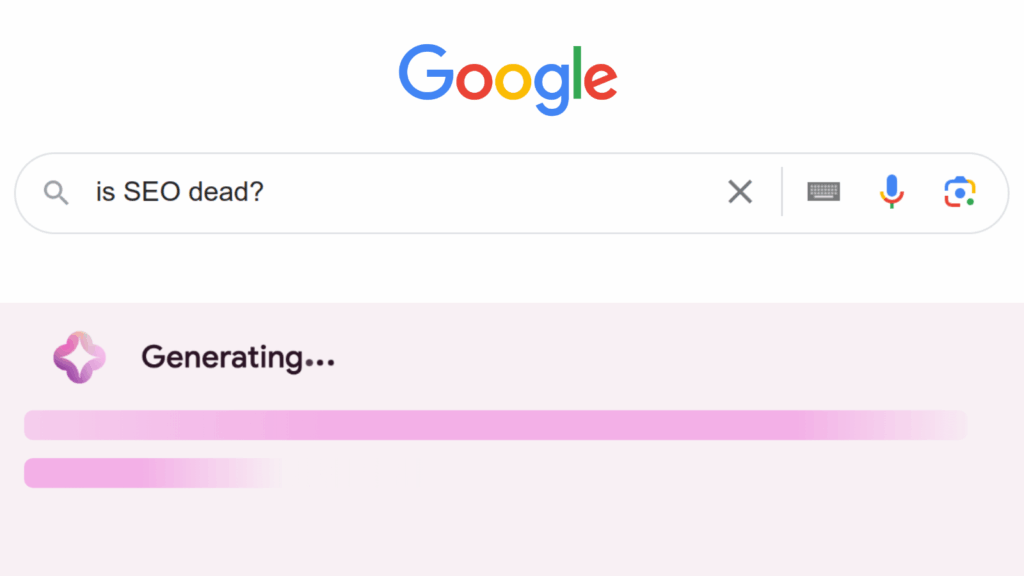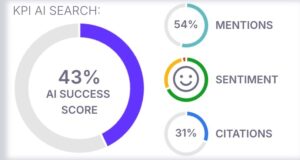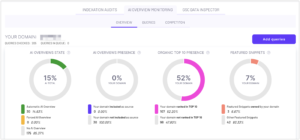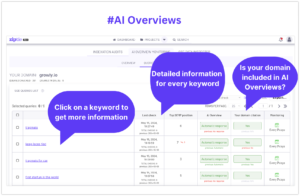Important!!!
Recently, Google reduced the number of AI Overviews. Check Tomek Rudzki’s Linkedin or Bart Goralewicz Linkedin for the latest info.
Google SGE is the most controversial and anxiety-provoking change in search. It follows uber-successful Bing’s AI copilot revolution and is already a top focal point for businesses relying on organic search.
With all the discussion around Google’s new AI interface SGE, especially the impact it is projected to have on traffic, branding, and user journeys, it is clear that SGE is a focus for most businesses that rely on organic search.
With Bing’s AI copilot success, we have seen quick adoption of an AI search experience, resulting in the quick rollout of SGE to all users, even expanding to the UK recently.
With so much changing week by week and with so few companies actually testing and tracking SGE’s rollout to the public, we put together the following State of SGE to help walk you through all the ins and outs based on the world’s most comprehensive research spanning over the last 10 months and including over 340,000 queries across 12 verticals.
SGE explained in 1 minute
SGE stands for “Search Generative Experience” and is a new feature that attempts to bring all the steps in a user’s journey into one interface, by placing an AI-generated overview right at the top of the search results.
This could have a tremendous impact on businesses, affecting the visibility and impact of your brand on potential customers, as well as potentially limiting the volume of traffic coming to your site.
Take a look at the screenshot below to see how SGE works for queries like: “iPhone 15 pros and cons”
SGE can have different layouts for various queries, but the basics are the same: it shows the AI-generated overview at the top of the search results.
See the SGE results for the query: “Who is Kim Kardashian dating”:
If you want to know more about the basics of SGE, I prepared a crash course on SGE.
If you want to check how SGE works but can’t access it in your country, I prepared a guide How to activate SGE (for beginners).
How will Google SGE impact search?
Here are three challenges associated with SGE:
- Impact on Clicks and Revenue: SGE will take over 82% of search pages leading to fewer clicks and potentially lower revenue, effectively keeping more of the traffic in Google.com.
- New competitors. New algo shifts from content to answers effectively promoting new players in search results. The playing field changes.
- Shift from keywords to conversation. It’s more like the experience you know from chatGPT. This is something that most people overlook, but it’s a massive change.
It will be less typing a keyword, like: “smartphone with a good camera” but more like having a conversation with a shop assistant.
So I can ask SGE: “I have a Samsung Galaxy S20. I’m looking for a new phone up to 1000 USD with a good camera, I’m interested mostly in landscape photography and good battery life”.
After SGE provides me with the answer, I can continue with follow-up questions:
A disclaimer, I’m not an Apple fanboy, it’s just a simulation 🙂 I don’t own a Samsung s20 either.
As a summary of how SGE will impact search, It’s clear that SGE and other AI search interfaces (such as chatGPT) are effective for users and are becoming widely adopted, which means you will continue to see SGE results across most markets including ones associated with your brand.
You cannot escape this change, but you can start working to make sure SGE works for you and your business.
TL;DR
- SGE will affect most of the queries. It covers 82% of queries on average, with the Finance niche being the only outlier at 47% and the beauty industry reaching 99%. So you need to develop an SGE strategy for your business.
- This point is overlooked most of the time, but extremely important: SGE shifts search from keywords to immersive user journeys and conversation. This means a challenge for keyword tracking and predicting people’s needs on various layers of the user journey.
- SGE will make it even harder to gain traffic from paid Google Ads by increasing cost and decreasing their effectiveness. Google SGE covers 87% of PPC queries over $1 so Google Ads may stop being a cheap source of getting traffic and leads for brands that aren’t successful in SEO. This may be further aggravated as many businesses losing their traffic may bid for Google Ads more aggressively.
- Brand New Ranking Algorithm: only 47% of the top 10 traditional search results are sources for SGE.
- User-generated content is favored by SGE (for instance, Quora and Reddit are popular sources for SGE)
- Reading Time: The average reading time for an SGE response is around 1 minute and 15 seconds making the SGE experience immersive
- Google’s SGE brings Opportunity for smaller players to compete with giants.
11 key Google SGE disruptions to prepare for in 2024
We distilled key takeaways from our research to show you areas you should focus on while preparing for the SGE revolution.
Our data indicates that for all searches, SGE is shown for around 82% and that number continues to increase.
With this in mind, you need to really begin focusing on creating content intended to be featured in SGE, or in the immediately surrounding features used in each specific user journey that applies to your customers.
Take the query: “Who is Kim Kardashian dating”. By looking at the SGE response, we can quickly notice what SGE is looking for:
- Recent info (from the recent month)
- Who Kim Kardashian is Dating (Odell Beckham Jr) and who he is.
- Words that can describe their relationship, such as: “palpable chemistry” or “mindful of not being too conspicuous”.
Google has no boundaries (with the “exception” of Finances)
We looked at 12 different industries and found that the four industries with the most SGE responses are Beauty (94.4%), Marketplace (93.8%), Automotive (90.11%), and E-commerce (86.6%)
Here is a breakdown of SGE responses by industry (vertical)
SGE is finance-averse
Google seems cautious about generating SGE responses for Fintech topics. For example, even for a search like “Abba Money,” which isn’t related to investing, Google doesn’t produce a default SGE response.
Although SGE seems wary of generating responses to Fintech queries, we have seen the number of SGE results grow from 22% in July 2023 to at least 47% of all Fintech searches today.
Since that number continued to rise, you should begin optimizing for SGE inclusion now, as Google is likely to continue to increase its SGE coverage for all industries over time.
Google SGE and ‘Your Money Your Life’ queries
Surprisingly, the likelihood of encountering SGE responses in the Health industry is quite high, at 77%.
This prompted me to take a closer look at the Health data by testing queries around very sensitive issues, more specifically, cancer-related queries, where accuracy and sensitivity are crucial. Even among these delicate topics, SGE appeared more than half the time—specifically, 52.86% of queries included an SGE response.
For reference, here is the SGE response for “cure cancer”:
Even if the response is based on trusted sources (such as WebMD), it’s still a very sensitive topic that, at least in my opinion, shouldn’t present any content generated by AI.
This observation suggests that if Google is willing to address sensitive health topics like cancer, it’s likely that other significant issues such as depression, obesity, and general mental health might also be covered through SGE without user prompts.
Takeaway:
It’s clear that SGE will affect every industry, with no exceptions. So businesses of all types should start optimizing for SGE.
Automatic SGE response is a bigger “risk” for businesses
One key thing to remember is that most SGE responses don’t just show up automatically. Often, you have to click a “generate” button to see them.
For instance, if you search for “types of marketing,” you need to click the “generate” button to get the SGE response.
So, in summary, SGE pops up on its own in about 34% of searches. In the other 66%, you need to click a button to see the SGE answer.
However, we expect this to change dramatically, as Google will have more information about the quality of the SGE responses and click data.
Let’s dive into specific niches.
It seems that currently, in the health sector, most SGE responses are automatically generated, which is quite remarkable.
In contrast, the Hotel industry mostly does not feature auto-generated SGE responses. However, this might change as Google gains more confidence from user feedback and click data.
As I mentioned, what’s particularly interesting about the health responses is that they are predominantly auto-generated. This might seem surprising at first, but it makes sense because many people look up general health information. Google can rely on trusted sources to provide accurate, comprehensive answers that satisfy user queries about general health practices. This is one of the easier areas for Google to navigate successfully due to the availability of reliable information, unlike more complex topics such as specific financial advice or investment tips, which require more nuanced handling.
Takeaway:
One of the strategies to maintain your visibility in search results is to prioritize SGE inclusion for queries with automated responses. The reason is simple: automated responses have more prominent space and more users will see them.
However, you should keep in mind that SGE is still in the experimental phase so it’s quite volatile. For instance, Google may decide to automatically generate SGE responses for queries that now are classified as: “user needs to click the button to see the SGE response”.
SGE is the new top 1
Here’s what you need to know: SGE shows up right at the top of the search results, just under any ads.
This setup pushes everything else on the search results page, like the usual top 10 blue links and the Top Stories carousels, further down.
Because of this, if your website is listed in the regular Google search results, your customers will have to scroll past the SGE section to find it, which could affect how many people actually see your site.
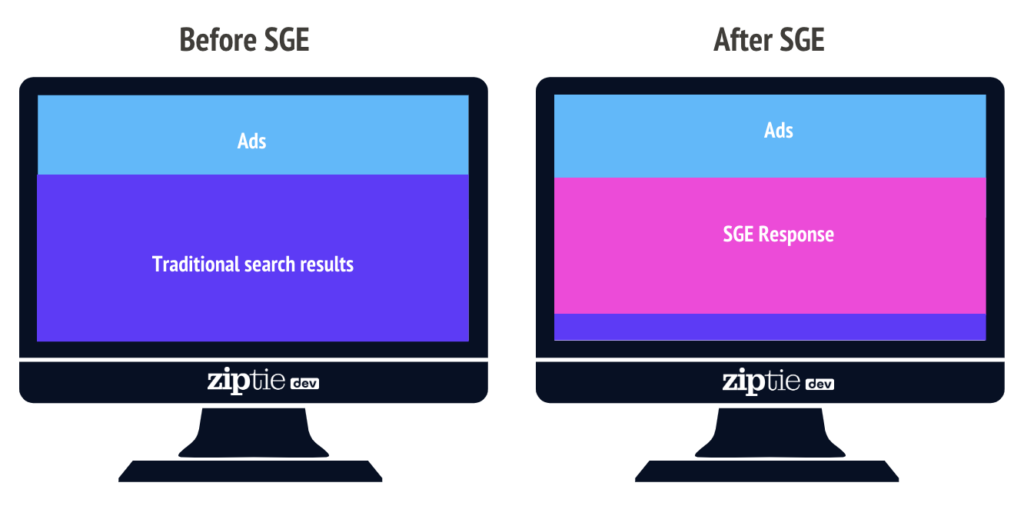
We looked into how much space SGE takes up on the screen. Our research found that on average, an SGE response uses about 905 pixels of space.
Considering that the most common screen resolution is 1920×1080, this means that in 84% of cases, SGE covers at least half of the screen right off the bat!
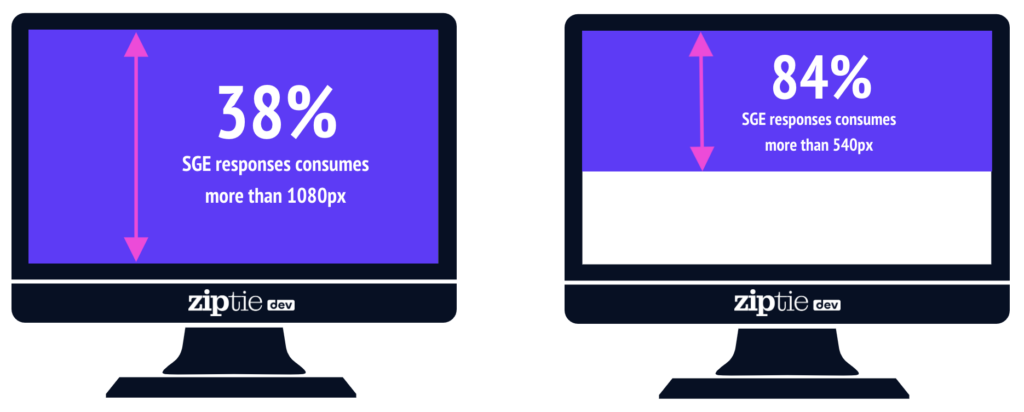
Takeaway: If you want your brand to be visible in search results, then you should prioritize SGE inclusion for queries with a height above at least half of the display. In the case of these queries, users will likely decide not to scroll to see “traditional” search results. In such a case you should try to get into SGE for these queries by preparing good, relevant content.
Top voices in Google’s SGE
We’ve pinpointed the most common sources used by SGE, both overall and within specific niches.
The most frequently cited source in SGE is blog.google. If you see this source in SGE, it means Google used its own data, for example, from Google Shopping Graph.
Here’s the full list of the 20 most common sources:
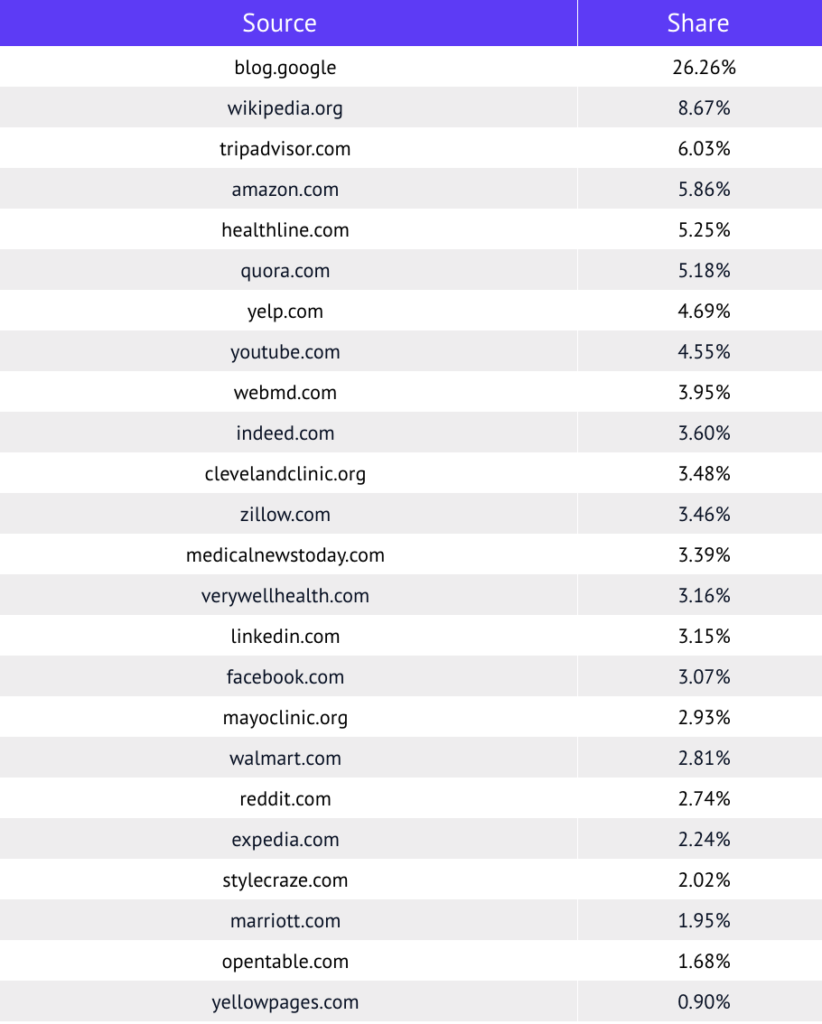
Following blog.google, Wikipedia is the second most common source, but the difference between the two is substantial. Blog.google is cited three times more often than Wikipedia.
There are a few other sources worth noting:
- User-generated content platforms like Quora and Reddit are surprisingly popular sources for SGE.
- Interestingly, Marriott, a hotel chain, is cited more frequently than larger online travel platforms like Booking.com or Airbnb.
How you can leverage top SGE for your brand success
Since SGE aggregates information from multiple sources, ensure your content strategy involves spreading information across various platforms and mediums. This could increase the chances of your content being picked up by SGE.
- Since user-generated content platforms like Quora and Reddit are popular sources for SGE, actively engaging on these platforms can help increase your visibility. Answer questions related to your industry, provide expert insights and link back to your detailed content when relevant. Given their influence in SGE responses, it’s wise for brands to monitor and manage how they’re portrayed on these platforms. If any information is misleading or inaccurate, consider correcting it.
- Wikipedia is a major source for SGE responses. To leverage this, ensure your brand is represented on Wikipedia and that the information is accurate. If not, SGE might spread incorrect details about your brand.
- Blog.google.com is significant in SGE, showing up in 26.26% of queries, particularly in the Automotive, Beauty, and Ecommerce sectors. Despite its name, it mainly pulls data from Google’s shopping graph, which lists products.
To make your brand visible here, consider following the steps to get listed in Google Merchant Center, as outlined in How to Use Google Merchant Center for Free Product Listings.
Marriott is notably outperforming giants like Airbnb and Booking.com in the hotel niche within SGE. If you’re in this space, it’s worth investigating what made Google favor Marriott in SGE.
Is it better content quality? Does the content at Marriott.com answer user queries better than its competitors?
Average reading time: 1m15s
We’ve looked into how long SGE responses typically are.
On average, an SGE response contains 222 words.
Given that the average person reads at a speed of 173 words per minute, it takes about 1 minute and 15 seconds to read an entire SGE response.
This tells us that SGE responses are quite detailed and lengthy. Many of them cover both sides of a story, pros and cons, and additional considerations.
Your SGE strategy can include:
- Find queries with lengthy SGE responses – there is a higher chance users won’t scroll to the “traditional” search results and you should consider looking for ways to start being featured in SGE for these queries
- Try to analyze SGE queries and find what SGE is looking for. Then prepare content intended for getting into the SGE results. I already covered this when I was discussing the case of the query: “who is Kim Kardashian dating”.
SGE will appear on both popular and less popular keywords
We already know that Google SGE appears for more than 81% of queries.
To better understand the pattern, we decided to group all the keywords we checked into three categories:
- Very popular keywords with over 10k monthly searches for instance: “iPhone 14)
- Relatively popular keywords 1k – 10k monthly searches
- Less popular keywords having 100-1000 monthly searches
We didn’t find ANY difference between how often SGE generates for both less popular and more popular.
This shows us that keyword popularity is NOT a factor that decides whether or not SGE will be generated.
So the chances are that Google SGE will appear for both: “buy iPhone 15” as well as a more conversational query like: “I would like to buy a phone with a good camera, especially for landscape photography. Another important point for me is good battery life.”
I included this section because I found many resources online showing long queries are more likely to generate responses. This implies you should mainly focus on long queries. It’s not true.
Instead, you should focus on other features such as: which keywords that are important for your niche have SGE responses and then try to optimize for them.
What’s crucial is you should try to understand the typical user journey and make your brand / online store present for each stage of their customer journey to increase the chances that they will use your services.
SGE is taking over money keywords
We decided to run another useful analysis.
We divided queries into three buckets, depending on query competitiveness:
- Expensive queries with Pay-per-click cost >$1
- Moderate cost queries with Pay-per-click cost 50 cents – 1$
- Cheap queries with Pay-per-click cost < 50 cents.
We noticed that SGE appears more frequently for more expensive keywords
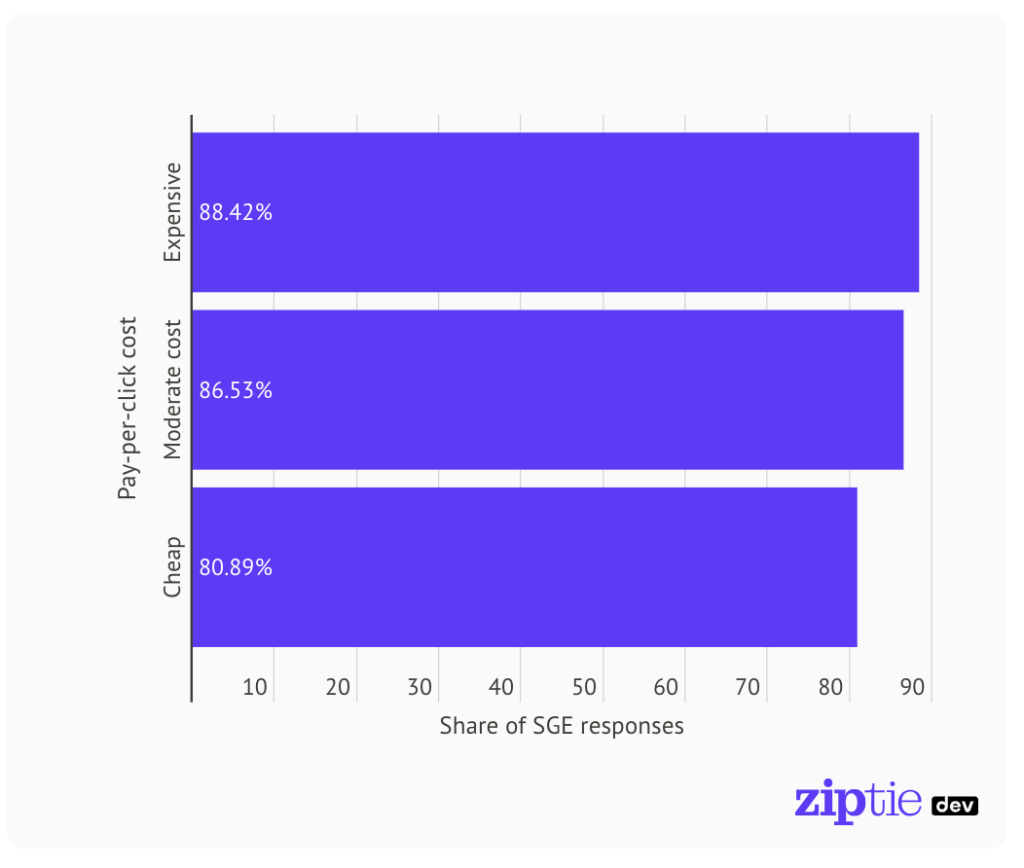
Takeaway: we can expect that the vast majority of queries will be covered by SGE, with money keywords in particular.
This means two things:
- SGE will make it even harder to gain traffic from paid Google Ads by increasing costs and decreasing their effectiveness. Google SGE covers 87% of PPC queries over $1 so Google Ads may stop being a cheap source of getting traffic and leads for brands not successful in SEO. This may be further aggravated as many brands losing their traffic may bid for Google Ads more aggressively.
- Seen from another perspective SGE can then save you money spent on ads. One of the strategies you can use is to identify keywords important for your business with the highest Cost-per-click and try to be featured in SGE.
More than 4 SGE spots to be taken
On average, the Google SGE response is based on 4.45 sources.

The biggest number of sources is taken into account for the food industry (5.21 sources on average).
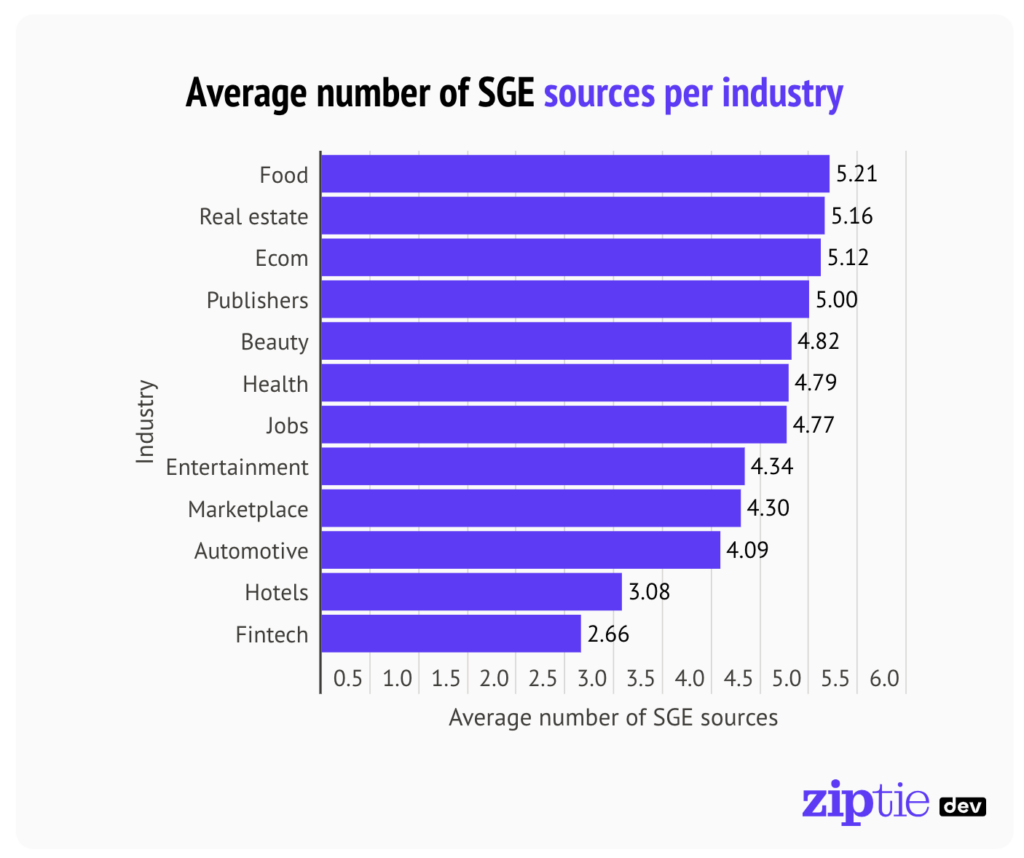
Based on the number of sources in a given industry we can estimate how difficult it is to get into SGE.
Our assumption is that if there are just two sources, Google is looking for basic information from trusted sources, and it’s more difficult to get there with your brand.
Having a big number of SGE sources may indicate Google is looking for a diversified set of sources.
So all things being equal it should be easier to get into SGE when the number of sources is higher.
Follow this experimental strategy to see if it makes you more successful in Google’s SGE.
SGE means new SEO rules
The above mentioned observation is intriguing for a couple of reasons. It’s now evident that Google SGE operates on a completely different level compared to traditional search. Remarkably, 53% of the sources used by SGE do not appear in the top 10 traditional search results.
Below I present a detailed breakdown per industry.
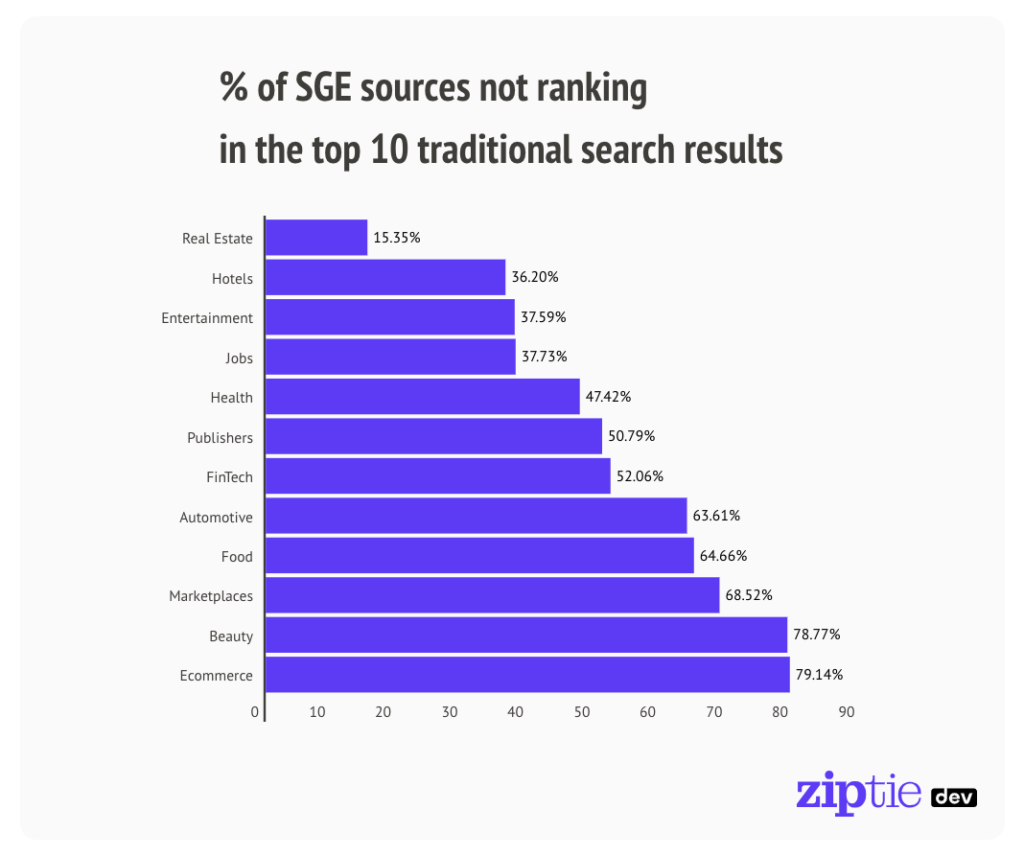
Takeaway:
This means that if you aim to be featured in Google SGE, you’ll need to develop a distinct strategy tailored to this new environment. It’s a whole new game.
Some areas for you to consider:
- Prepare a content strategy to cover various stages of the buying process (at the beginning people don’t type: “buy iPhone 15”, they rather try to find more information about its camera quality, and battery life. To ensure SGE success you should be present at every stage of their journey.
- Prepare content fragments that clearly answer a given query. For instance, users typing “who is Kim Kardashian dating” probably don’t care about her childhood. They want a CLEAR answer. And this is something your content should reflect.
- Technical optimization of the website – it’s important to make your content easily digestible for Google robots. Just as Google search used Googlebot to rank pages, now SGE is using Googlebot to source pages for answers to queries.
SGE appears 5.53x more than Featured Snippets
As you might already be aware, SGE functions quite differently from traditional search features like the Featured Snippet. SGE pulls information from multiple sources, whereas a Featured Snippet typically gathers data from just one source.
Our data shows that SGE appears 5.53x more than Featured Snippets across various searches.
Here’s the detailed breakdown per industry:
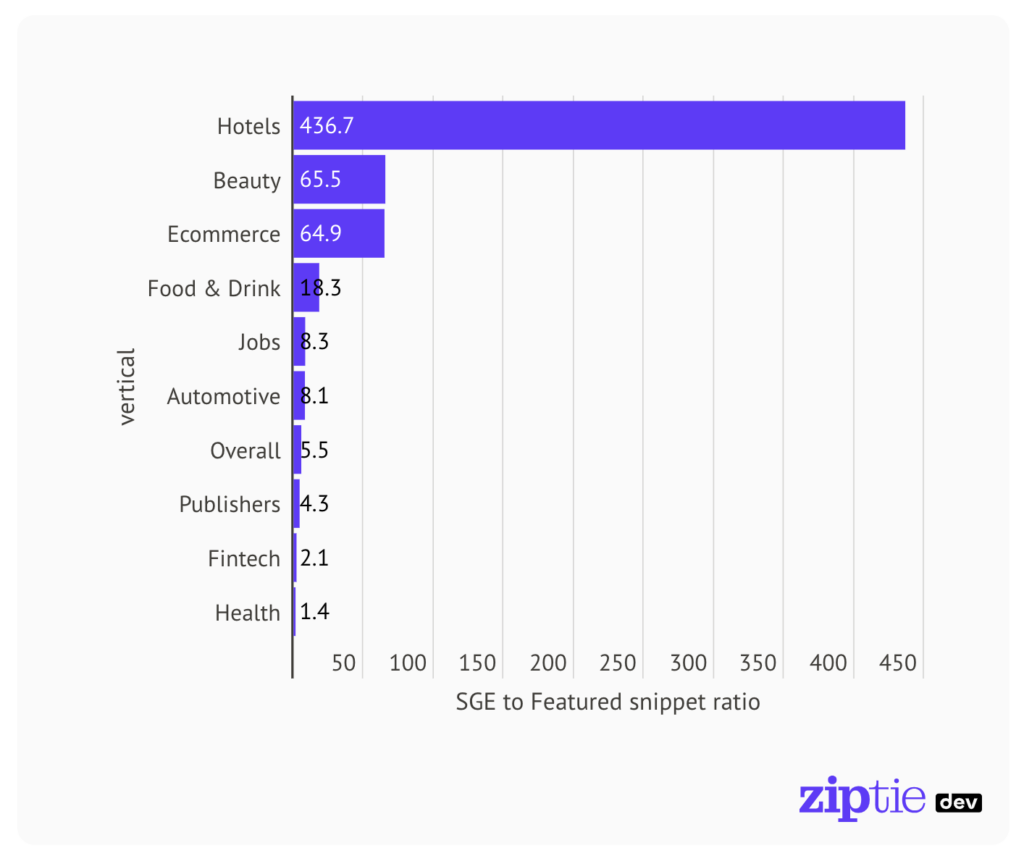
What really amazed me was seeing the difference in their frequency within the hotel industry. In the hotel industry, SGE shows up 437 times more than Featured Snippets (!)
This significant disparity highlights just how differently SGE operates compared to more traditional search features.
Takeaway:
Given the significant difference in the ratio of SGE results compared to Featured Snippets, especially in industries like hotels where SGE appears 437 times more, it’s clear that optimizing for Featured Snippets is not enough – SGE gets a more prominent place and appears much more than Featured snippets. Your strategy can involve monitoring whether or not your brand appears both in SGE and featured snippets. You can do it manually or using ZipTie.dev.
Summary
As outlined in the article, we expect SGE will revolutionize search and its impact on businesses, and publishers relying on traffic from Google.
It’s a totally new playing field and a different ranking system (meaning you can rank high in SGE, but not rank in traditional search results).
However, as the case of relatively small players, such as the Marriott hotel chain, or Bobvila (e-commerce industry) shows it’s clear that small players can successfully compete agains hegememoms, such as AirbBnb, Booking.com, or Amazon.
To prepare for SGE you have to prepare a distinct strategy that includes:
- Check which competitors are successful in SGE
- Spend some time trying to analyze what made Google choose them over your content (it could be content quality, content relevancy, or technical SEO optimization. Or maybe they just provide a direct answer that satisfies Google’s SGE? A lot of things come into play and it’s interesting to observe and experiment with what works for SGE and what doesn’t work.
- Improve your content to be featured in SGE.
Methodology
In late March 2024, we utilized our custom-developed software at ZipTie.dev to scrape 490,000 keywords in Google US. The initial step involved selecting industries to ensure a broad coverage of online businesses. The e-commerce sector alone represents a significant portion of various businesses, and we expanded our research to include 11 additional industries, such as health or finance.
For each industry, we identified leading companies and used Ahrefs to determine which search queries they ranked for in the “traditional” Google. We then selected keywords for each domain based on their popularity, categorizing them into three groups based on search volume: 100-1,000, 1,000-10,000, and over 10,000. To maintain neutrality and avoid biases toward specific companies, we excluded brand-specific queries.
To ensure accuracy and reliability in data collection, our scraper is designed to retry in case of errors and uses multiple randomly selected accounts, minimizing the impact of personalization.
We conducted our data analysis using three tools: Excel, KNIME, and a custom Python script.
